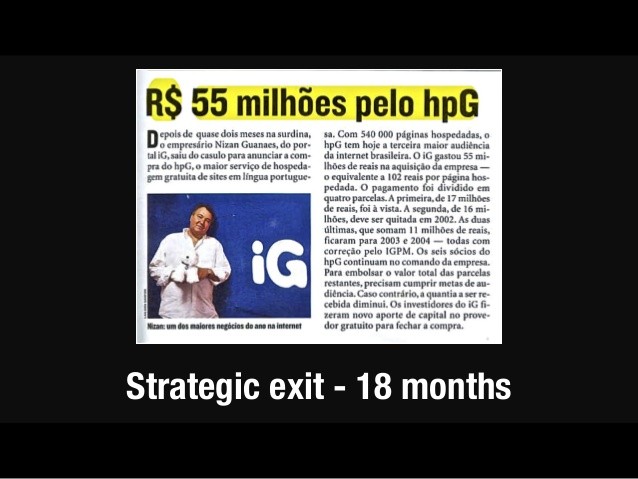What Startups Need to Know About Exit Strategies
Post on: 14 Июль, 2016 No Comment

The exit strategy isnt about you, its about your investors.
Startups looking for angel investors or venture capital (VC) absolutely need an exit strategy because investors require it. The exit is what gives them a return.
Exit strategies related to startup funding are quite often misunderstood: The exit in exit strategy is for the money, not the startup founders or small business owners. The company brings in money and the investors get money out. So startups looking for angel investors or venture capital (VC) absolutely need an exit strategy because investors require it. The exit is what gives them a return. And the rest of us, starting, running, and growing a business, but not looking for outside investors, will probably need an exit eventually; but there’s probably no rush.
The exit strategy related to startup funding, is what happens when investors who had previously put money in a startup get money back, usually years later, for a lot more money than they initially spent. For example, that’s what Crunchbase was talking about when it published The Average Successful Startup Raises $41M, Exits at $242.9M last December. And that’s what happened earlier this month when LinkedIn bought Newsle: deal terms weren’t announced but two venture capital firms had spent $2.6 million buying shares (investing in) Newsle, and unconfirmed reports have LinkedIn paying $30 million, so we can assume the two VC firms had a happy exit pocketing a lot more than the original $2.6 million. That’s the classic investor return on investment.
Investor exits normally happen in only two ways: Either the startup gets acquired by a bigger company, for enough money to give the investors a return (as just happened with Newsle), or the startup grows and prospers enough to eventually register for selling shares of stock to the buying public over a public stock market, as happened with Facebook in 2012 and Twitter in 2013.
The traditional exit strategy
When investors sit for pitches from startups, they expect the startups to cover the exit strategy. That usually means talking, in the pitch and in the business plan, about how similar companies in similar markets have been able to exit via selling out to a larger company. The more sophisticated plans and pitches will mention recent exits and offer information about how the companies that exited were valued when they were bought. That usually ends up as something like “[this similar company] was purchased by [that company] in [that year] for [that amount], which was [that multiple] of its revenues. The standard phrase in that context is “5X” for an exit value of five times revenues, or “10X,” or whatever. And that should not be confused with similar phrasing describing the investors’ exit: an exit at “5X,” for example, would be one in which the investors received an actual exit amount, in money or shares they can sell, of five times what they originally invested.
You can understand how investors feel about exit strategy if you consider what happens to investors who don’t get exits. They don’t have a return. They put money into a company, but they get nothing back. Having a minority share in a healthy, growing company, without any prospect of an exit, is a terrible scenario for investors. My own angel investment activities include more than one investment in companies that are still healthy, still growing, still have happy founders, but no good prospects for exits in the foreseeable future. And that scenario, while it can be very good for the founders, is terrible for the investors.
I’ve been a member of an angel investment group for more than six years now, and I’ve been involved in reviewing the possibilities (studying the possible deals, which we call “due diligence”) every year. And as a group, we all worry about deals that don’t seem to offer likely exits, and we worry just as much or more about investing in startups whose founders don’t seem to understand and acknowledge the need from the investor point of view.

A different type of exit strategy
Aside from the investor-oriented exit strategy, which is a factor in every outside investment, you’ll occasionally hear about a different kind of exit, when the startup founders, the entrepreneurs themselves, sell their company and turn their ownership in a business into money. This happens most often as people get older and want to finish their careers. More rarely, you’ll encounter younger entrepreneurs whose vision from the start was to establish a business, grow it fast to make it attractive to a purchaser, and sell. These are also exits.
I’ve had personal experience with several variations on the classic exits. As a founding director of Borland International, I had significant shares in that company when it went public in 1986, and that gave me an exit. I’d acquired the shares as compensation for planning and advice, not by investing money; so the return wasn’t measurable in the standard way. In 2002 I provided an exit for VCs who had invested in Palo Alto Software a few years earlier. Valuations had changed and we weren’t looking to be acquired, so we bought out their shares to avoid locking them in forever as minority share holders in a company that wasn’t going public and wasn’t going to be acquired. Since 2009 I’ve been involved in seven investments by the angel investment group I participate in; and we haven’t had any exits yet.
Do you know how to write and pitch an effective exit strategy? Do you have any questions? Share with us in the comments below.
About the Author Tim Berry is the founder and chairman of Palo Alto Software and Bplans.com. Follow him on Twitter @Timberry. Follow Tim on Google+ Read more














